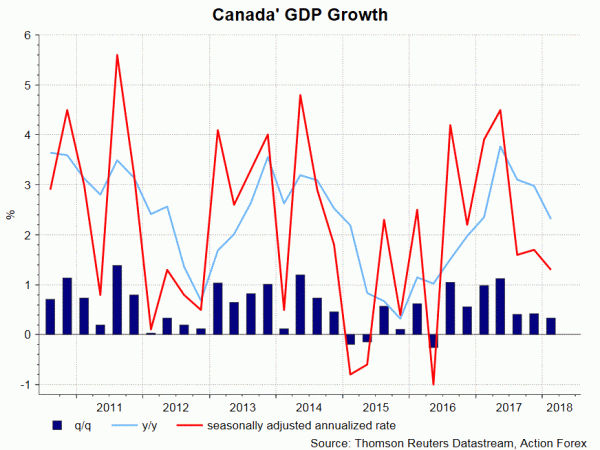Since the BOC meeting in May, at which the policymakers removed the “cautious” rhetoric, the market has been raising its bet on a July rate hike. As of today, the market has priced in over 90% chance of a +25 bps rate hike at this week’s meeting. GDP growth in April (released in June) reinforced the underlying strength in domestic economy. The employment situation remained firm. However, while June payrolls increased, the unemployment rate also climbed higher. Headline CPI in May missed expectations but still exceeded BOC’s target of +2%. Core CPI eased for a second consecutive month. The ongoing uncertainty is future trade relations with the US, including NAFTA renegotiation, and US’ imposition of trade tariff and Canada’s retaliatory measures. After all, BOC’s monetary policy stance should continue to be data-dependent.
GDP growth in April eased to +0.1% q/q, but beat expectations of no growth. In the first quarter, GDP expanded +0.3% q/q and an annualized rate of +1.3%. The moderation in April growth was attributed to temporary factors, including to adverse weather a number of maintenance shutdowns in the oil sands sector, which would have dissipated in the second quarter. Headline inflation rate steadied at +2.2% y/y in May, compared with consensus of +2.6%. Energy prices, surging +11.6% as driven by a +23% jump in gasoline price, were offset by falling prices in other areas including telephone services, traveler accommodation and computers. Excluding energy, inflation steadied +1.6%, down from +1.9% in April. Core CPI, excluding energy and food, eased to +1.7%, from +1.8% in April and +1.9% in March. BOC’s three core measures all averaged at +1.9% for the month.
On the job market, payrolls in June increased +31.8K, beating consensus of +24K and May’s contraction of -7.5K. The increase in payrolls mainly came from goods-producing. Indeed, services employment fell after 4 months of solid gains. Unemployment rate climbed +0.2 percentage point to +6%. Since the rise in the unemployment rate was driven by a +0.2 percentage point growth in the participation rate, and given the fact that the unemployment rate still stays at the lowest level in decades, the overall job market in Canada remains upbeat. Wage growth eased slightly to +3.5% y/y. The strongest momentum came from Ontario and British Columbia provinces. Both provinces raised minimum wages this year.
While economic developments have largely come in line with BOC’ April forecast, the major uncertainty is the uncertain trade relations between Canada and the US. Besides the slow progress of NAFTA negotiations, US unexpected imposition of steel and aluminum tariff on Canada has triggered retaliatory measures from the latter. Meanwhile, Trump has lately threatened to impose tariff on auto imported from Canada. These have inevitably posed downside risk on Canada’s growth outlook
We expect BOC to adopt a so-called “dovish tightening” at the upcoming meeting. While announcing to raise the policy rate by +25bps to 1.5%, policymakers would reaffirm the uncertainty of the trade outlook and reiterate that further monetary policy decision would depend on incoming data.


 Signal2forex.com - Best Forex robots and signals
Signal2forex.com - Best Forex robots and signals




